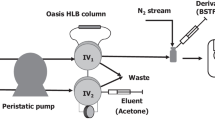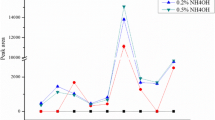Abstract
Simultaneous analysis of 11 free estrogen hormones and five conjugated estrogens in water and municipal wastewater was studied. The analytical method was developed and tested for different types of solid-phase extraction adsorbents, eluents, sample containers and storage conditions, derivatization, and matrix effects. Varian Bond Elut C-18 solid-phase extraction adsorbent cartridge was selected based on its high recoveries for both free and conjugated estrogens. Sample storage conditions, as well as selection and pretreatment of sample container materials, can affect the trace level analysis of estrogens. Silanization of glassware is observed to provide low relative standard deviation (RSD) in the analysis and less percentage loss due to contacting with sample container materials. Light exposure during the test can significantly impact the results. The derivatized samples stored at −20°C for at least 6 days showed less than 10.5% average RSD in the analysis. The recovery efficiency in clean water varies from 72% to 101% for free estrogens and 78% to 82% for conjugated estrogens. The method detection limits (MDL) for most of the compounds range from 30 to 870 ng/L using a sample volume of 200 mL. With a sample volume of 3 L, the most sensitive compound produces a MDL of 0.03 ng/L. Dilute methanol is used to wash the loaded cartridge as a cleanup step in order to remove interfering species during analysis of wastewater samples. Using the optimized analytical methods, the concentration level of free estrogens in the influent and effluent municipal wastewaters is tested.
Similar content being viewed by others
References
Andersen, H., Siegrist, H., Halling-SøRensen, B., & Ternes, T. A. (2003). Scrutinizing pharmaceuticals and personal care products in wastewater treatment. Environmental Science Technology, 37, 4021–4026.
Belfroid, A. C., Van der Horst, A., Vethaak, A. D., Schafer, A. J., Rijs, G. B., Wegner, J., et al. (1999). Analysis and occurrence of estrogenic hormones and their glucuronides in surface water and waste water in The Netherlands. Science of the Total Environment, 225, 101–108.
Chimchirian, R. F., Suri, R. P. S., & Fu, H. (2007). Free synthetic and natural estrogen hormones in influent and effluent of three municipal wastewater treatment plants. Water Environmental Research, 79(9), 969–974.
Coleman, H. M., Routledge, E. J., Sumpter, J. P., Eggins, B. R., & Byrne, J. A. (2004). Rapid loss of estrogenicity of steroid estrogens by UVA photolysis and photocatalysis over an immobilised titanium dioxide catalyst. Water Research, 38, 3233–3240.
D’Ascenzo, G., Di Corcia, A., Gentili, A., Mancini, R., Mastropasqua, R., Nazzari, M., et al. (2003). Fate of natural estrogen conjugates in municipal sewage transport and treatment facilities. Science of the Total Environment, 320, 199–209.
Gabet, V., Miege, C., Bados, P., & Coquery, M. (2007). Analysis of estrogens in environmental matrices. Trends in Analytical Chemistry, 26, 1113–1131.
Halling-Sorensen, B., Nielsen, S. N., Lanzky P. F., Ingerslev, F., Lützhøft, H. C. H., & Jørgensen, S. E. (1998). Occurrence, fate and effects of pharmaceutical substances in the environment - A review. Chemosphere, 36(2), 357–393.
Johnson, A. C., & Sumpter, J. P. (2001). Removal of endocrine-disrupting chemicals in activated sludge treatment works. Environmental Science Technology, 35, 4697–4703.
Khanal, S. K., Xie, B., Thompson, M. L., Sung, S., Ong, S., & Van Leeuwen, J. (2006). Fate, transport, and biodegradation of natural estrogens in the environment and engineered systems. Environmental Science Technology, 40, 6537–6546.
Kolpin, D. W., Furlong, E. T., Meyer, M. T., Thurman, E. M., Zaugg, S. D., Barber, L. B., et al. (2002). Pharmaceuticals, hormones, and other organic wastewater contaminants in U.S. streams, 1999–2000: A national reconnaissance. Environmental Science Technology, 36, 1202–1211.
Kuch, H. M., & Ballschmiter, K. (2001). Determination of endocrine-disrupting phenolic compounds and estrogens in surface and drinking water by HRGC-(NCI)-MS in the Picogram per liter range. Environmental Science Technology, 35, 3201–3206.
Lai, K. M., Johnson, K. L., Scrimshaw, M. D., & Lester, J. N. (2000). Binding of waterborne steroid estrogens to solid phases in river and estuarine systems. Environmental Science Technology, 34, 3890–3894.
Larsson, D. G. J., Adolfsson-Erici, M., Parkkonen, J., Pettersson, M., Berg, A. H., Olsson, P. E., et al. (1999). Ethinyloestradiol - an undesired fish contraceptive. Aquatic Toxicology, 45, 91–97.
Lee Ferguson, P., Iden, C. R., McElroy A. E., & Brownawell, B. J. (2001). Determination of steroid estrogens in wastewater by immunoaffinity extraction coupled with HPLC-Electrospray-MS. Analytical Chemistry, 73, 3890–3895.
Lopez de Alda, M. J., & Barcelo, D. (2001). Use of solid-phase extraction in various of its modalities for sample preparation in the determination of estrogens and progestogens in sediment and water. Journal of Chromatography A, 938, 145–153.
Petrovic, M., Eljarrat, E., Lopez de Alda, M. J., & Barcelo, D. (2002). Recent advances in the mass spectrometric analysis related to endocrine disrupting compounds in aquatic environmental samples. Journal of Chromatography A, 974, 23–51.
Purdom, C. E., Hardiman, P. A., Bye, V. J., Eno, N. C., Tyler, C. R., & Sumpter, J. P. (1994). Estrogenic effects of effluents from sewage treatment works. Journal of Chemistry and Ecology, 8, 275–285.
Quintana, J. B., Carpinteiro, J., Rodríguez, I., Lorenzo, R. A., Carro, A. M., & Cela, R. (2004). Determination of natural and synthetic estrogens in water by gas chromatography with mass spectrometric detection. Journal of Chromatography - A, 1024, 177–185.
Richardson, S. D., & Ternes, T. A. (2005). Water analysis: Emerging contaminants and current issues. Analytical Chemistry, 77, 3807–3838.
Rodgers-Gray, T. P., Jobling, S., Steven, M., Kelly, C., Kirby, S., Janbakhsh, A., et al. (2000). Long-term temporal changes in the estrogenic composition of treated sewage effluent and its biological effects on fish. Environmental Science Technology, 34, 1521–1528.
Routledge, E. J., Sheahan, D., Desbrow, C., Brighty, G. C., Waldock, M., & Sumter, J. P. (1998). Identification of estrogenic chemicals in STW effluent. 2. In vivo responses in trout and roach. Environmental Science Technology, 32, 1559–1565.
Sanderson, H., Brain, R. A., Johnson, D. J., Wilson, C. J., & Solomon, K. R. (2004). Toxicity classification and evaluation of four pharmaceuticals classes: Antibiotics, antineoplastics, cardiovascular, and sex hormones. Toxicology, 203, 27–40.
Shore L. S., & Shemesh, M (2003). Naturally produced steroid hormones and their release into the environment. Pure and Applied Chemistry, 75, 1859–1871.
Suri, R. P. S., Singh, T. S., & Abburi, S. (2010). Influence of alkalinity and salinity on the sonochemical degradation of estrogen hormones in aqueous solution. Environmental Science Technology, 44, 1373–1379.
Ternes, T. A., Joss, A., & Siegrist, H. (2004). Scrutinizing pharmaceuticals and personal care products in wastewater treatment. Environmental Science Technology, 38, 393A–399A.
USEPA (2007) Method 1698: Office of science and technology, engineering and analysis division. December 2007.
Vanderford, B. J., & Snyder, S. A. (2006). Analysis of pharmaceuticals in water by isotope dilution liquid chromatography/tandem mass spectrometry. Environmental Science Technology, 40, 7312–7320.
Vanderford, B. J., Pearson, R. A., Rexing, D. J., & Snyder, S. A. (2003). Analysis of endocrine disruptors, pharmaceuticals, and personal care products in water using liquid chromatography/tandem mass spectrometry. Analytical Chemistry, 75, 6265–6274.
Xia, K., Bhandarim, K., Das, A., & Pillar, G. (2005). Occurrence and fate of pharmaceuticals and personal care products (PPCPs) in biosolids. Journal of Environmental Quality, 34, 91–104.
Xiao, X., McCalley, D. V., & McEvoy, J. (2001). Analysis of estrogens in river water and effluents using solid-phase extraction and gas chromatography-negative chemical ionisation mass spectrometry of the pentafluorobenzoyl derivatives. Journal of Chromatography A, 923, 195–204.
Yamamoto, A., Kakutani, N., Yamamoto, K., Kamiura, T., & Miyakoda, H. (2006). Steroid hormone profiles of urban and tidal rivers using LC/MS/MS equipped with electrospray ionization and atmospheric pressure photoionization sources. Environmental Science Technology, 40, 4132–4137.
Author information
Authors and Affiliations
Corresponding author
Rights and permissions
About this article
Cite this article
Suri, R.P.S., Singh, T.S. & Chimchirian, R.F. Effect of process conditions on the analysis of free and conjugated estrogen hormones by solid-phase extraction–gas chromatography/mass spectrometry (SPE–GC/MS). Environ Monit Assess 184, 1657–1669 (2012). https://doi.org/10.1007/s10661-011-2068-9
Received:
Accepted:
Published:
Issue Date:
DOI: https://doi.org/10.1007/s10661-011-2068-9




